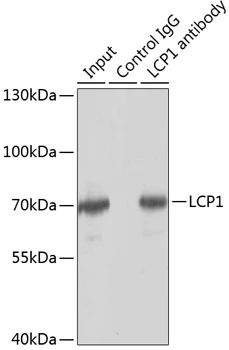L-Plastin antibody
GTX105789
ApplicationsImmunoFluorescence, Western Blot, ImmunoCytoChemistry, ImmunoHistoChemistry, ImmunoHistoChemistry Frozen, ImmunoHistoChemistry Paraffin
Product group Antibodies
TargetLCP1
Overview
- SupplierGeneTex
- Product NameL-Plastin antibody
- Delivery Days Customer9
- Application Supplier NoteWB: 1:5000-1:20000. ICC/IF: 1:100-1:1000. IHC-P: 1:100-1:1000. *Optimal dilutions/concentrations should be determined by the researcher.Not tested in other applications.
- ApplicationsImmunoFluorescence, Western Blot, ImmunoCytoChemistry, ImmunoHistoChemistry, ImmunoHistoChemistry Frozen, ImmunoHistoChemistry Paraffin
- CertificationResearch Use Only
- ClonalityPolyclonal
- Concentration1.28 mg/ml
- ConjugateUnconjugated
- Gene ID3936
- Target nameLCP1
- Target descriptionlymphocyte cytosolic protein 1
- Target synonymsCP64, HEL-S-37, L-PLASTIN, LC64P, LPL, PLS2, plastin-2, L-plastin (Lymphocyte cytosolic protein 1) (LCP-1) (LC64P), LCP-1, Lymphocyte cytosolic protein-1 (plasmin), bA139H14.1 (lymphocyte cytosolic protein 1 (L-plastin)), epididymis secretory protein Li 37
- HostRabbit
- IsotypeIgG
- Protein IDP13796
- Protein NamePlastin-2
- Scientific DescriptionPlastins are a family of actin-binding proteins that are conserved throughout eukaryote evolution and expressed in most tissues of higher eukaryotes. In humans, two ubiquitous plastin isoforms (L and T) have been identified. Plastin 1 (otherwise known as Fimbrin) is a third distinct plastin isoform which is specifically expressed at high levels in the small intestine. The L isoform is expressed only in hemopoietic cell lineages, while the T isoform has been found in all other normal cells of solid tissues that have replicative potential (fibroblasts, endothelial cells, epithelial cells, melanocytes, etc.). However, L-plastin has been found in many types of malignant human cells of non-hemopoietic origin suggesting that its expression is induced accompanying tumorigenesis in solid tissues. [provided by RefSeq]
- Storage Instruction-20°C or -80°C,2°C to 8°C
- UNSPSC12352203
References
- Vanhunsel S, Bergmans S, Beckers A, et al. The killifish visual system as an in vivo model to study brain aging and rejuvenation. NPJ Aging Mech Dis. 2021,7(1):22. doi: 10.1038/s41514-021-00077-4Read this paper
- Chen JY, Chou HC, Chen YH, et al. High glucose-induced proteome alterations in hepatocytes and its possible relevance to diabetic liver disease. J Nutr Biochem. 2013,24(11):1889-910. doi: 10.1016/j.jnutbio.2013.05.006Read this paper






